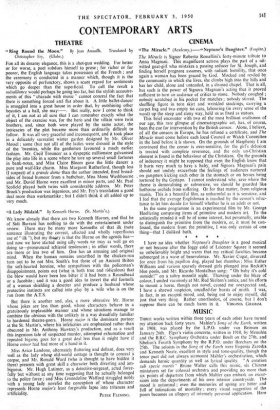MUSIC
THREE works written within three years of each other have turned my attention back forty years. Mahler's Song of the Earth, written in 1908, was played by the L.P.O. under van Beinum on January 26th. Elgar's violin concerto, written in 1910, by Menuhin and the B.B.C. Symphony Orchestra under Boult on the 27th, and Sibelius's Fourth Symphony by the R.P.O. under Beecham on the 25th. The soloists in the Song of the Earth were Eugenia Zareska and Kenneth Neate, excellent in style and tone-quality, though the tenor part did not always surmount Mahler's orchestration, which demands heroic quantity as well as lyrical *quality. "A creation sub specie mortis" Bruno Walter calls this music, six Chinese miniatures set for colossal orchestra and providing no more than six points of departure from which Mahler can embark on excur- sions into the departments of his own interior countryside. The mood is autumnal ; even the memories of spring are bitter and full of intimations of mortality ; every visual suggestion of the poem becomes an allegory of intensely personal application. Here
Mahler rambles, certainly, but never proses ; and for unfailing poetry and personal expressiveness the Song of the Earth has no rivals in his works after the early Lieder eines fahrenden Geselien.
After vicissitudes which obtained far more Press attention than the object for which they were undergone, Menuhin naturally played with less than his accustomed finish and detachment. No violin concerto more than Elgar's combines musical quality with virtuosity. The tone, the temperament, the aptitudes (occasionally even the ineptitudes) of the violin are the inspiration of the music just as truly as any prima donna inspired the operatic composer of an earlier day. Though the musical ideas and their treatment are always highly respectable, it is the violin's treatment of them that holds our attention. The plays written for Bernhardt or Duse seldom pass muster with lesser actresses as protagonists, and Elgar's concerto needs a similar giant in the title-role. Circumstances pre- vented Menuhin from perfectly filling the part.
Sibelius's fourth symphony has the reputation of a forbidding work, but if this means that the composer's intentions are not clear in performance, Sir Thomas Beecham may be said to have disproved the accusation. This music does not come to meet the listener, nor is it ever smiling or complacent ; but, at least in this perform- ance, it was perfectly clear. The individual listener may prefer more humanity, more warmth or more bonhomie, but the com- poser puts before him, without a moment's hesitation or fumbling, a perfectly articulated construction whose poetry and significance cannot be called in question.
* *
Raymond Trouard played Liszt's E flat major and Ravel's G major piano concertos with the Philhatmonia Orchestra at the New Era Society's concert on January 31st. This was piano-playing on a grand scale, which showed up the age of the Albert Hall instru- ment in moments of climax. The first and last movements of Ravel's concerto are indeed diverting (he planned the work as a divertissement), but the middle movement suffers from a short- winded, broken-backed melody which irritates rather than diverts.
MARTIN COOPER.



































 Previous page
Previous page